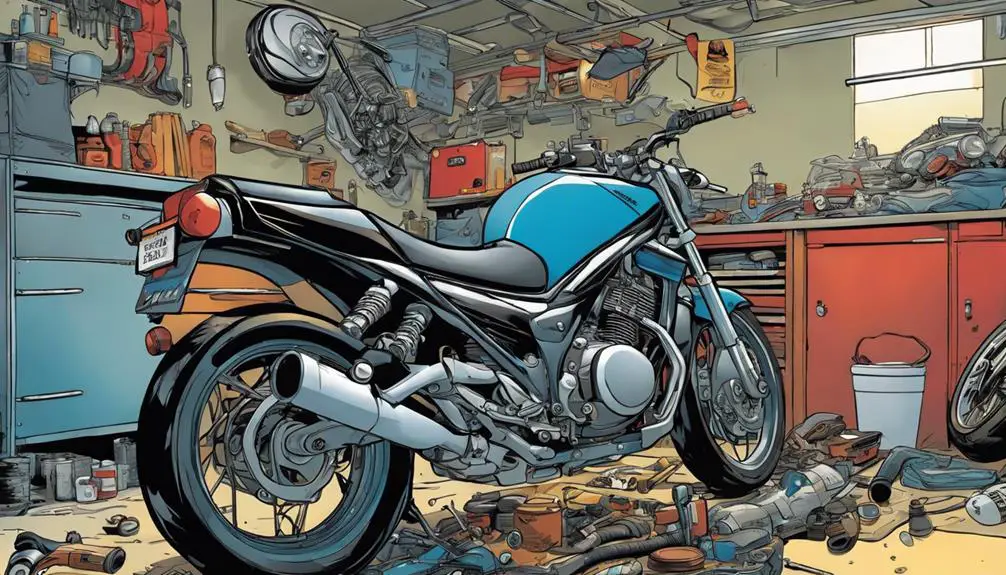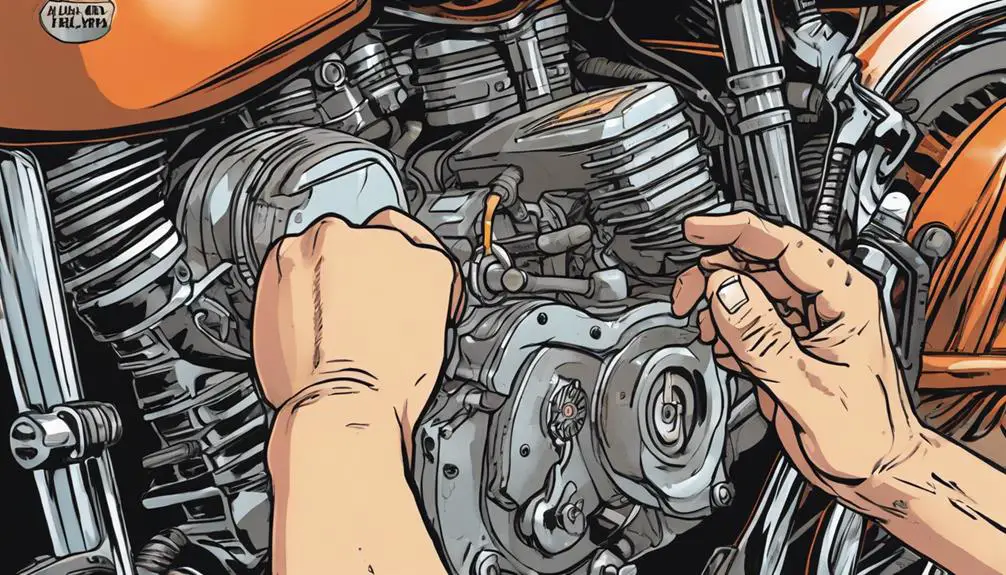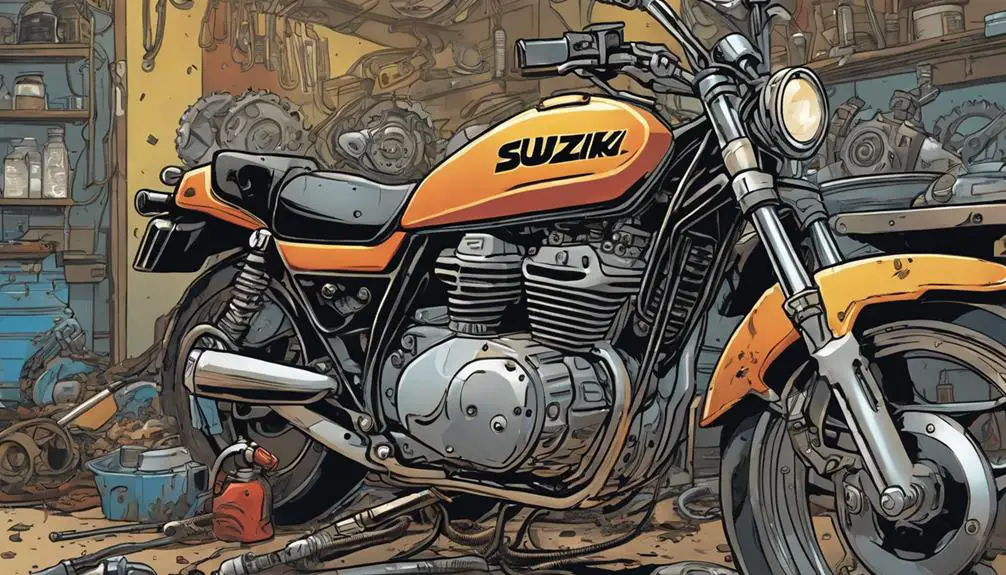You might not realize that many motorcycle maintenance issues stem from a mix of rider habits and specific design flaws in certain models. As you ride more, it's easy to overlook routine checks like tire pressure and oil levels, leading to bigger problems down the line. Riders often share their experiences, but what drives them to report these issues? Understanding the interplay of wear and tear, maintenance neglect, and user feedback can shed light on a larger conversation about motorcycle care and safety.
Quick Takeaways
- Common motorcycle maintenance issues often arise from a lack of regular inspections, leading to neglect of critical components like tires and engines.
- Riders frequently experience performance problems due to dirty fuel filters and worn spark plugs, impacting overall efficiency and power.
- Tire wear patterns, such as center or edge wear, signify improper inflation or misalignment, which are often overlooked during routine maintenance.
- Corrosion and fluid leaks, particularly in older models, are prevalent issues that many riders face due to insufficient maintenance practices.
Overview of Suzuki Motorcycles

Suzuki motorcycles, known for their reliability and performance, cater to a diverse range of riders, from beginners to seasoned enthusiasts. Whether you're hitting the open road or steering through city streets, you'll find a model that matches your spirit of adventure. The brand's commitment to quality guarantees you get a machine that's durable and efficient, allowing you to focus on the ride instead of worrying about breakdowns.
When you choose a Suzuki, you're not just selecting a motorcycle; you're embracing a lifestyle of freedom and exploration. Each model is designed with rider comfort and control in mind, providing a smooth experience that empowers you to conquer any terrain. From the nimble GSX series to the rugged V-Strom, you've got options that fit your personality and riding style.
Suzuki also prioritizes innovation, incorporating advanced technology that enhances performance and safety. This means you can enjoy cutting-edge features without sacrificing the raw thrill of riding. With a Suzuki, you'll feel the wind in your hair and the road beneath your wheels, reminding you that every journey is yours to own. So gear up and let your Suzuki take you wherever your heart desires.
Common Maintenance Issues
When you're on the road, engine performance problems and tire wear patterns can really affect your ride.
It's essential to keep an eye on these common issues to guarantee your motorcycle runs smoothly and safely.
Let's explore what you need to watch for to maintain your bike's peak performance.
Engine Performance Problems
Experiencing engine performance problems can be frustrating, but addressing common maintenance issues early can help keep your motorcycle running smoothly. You might notice a lack of power, strange noises, or difficulty starting. These symptoms often point to underlying issues like dirty fuel filters, clogged air intakes, or worn spark plugs.
To liberate your ride from these annoyances, start with regular inspections. Check your fuel system for contamination, and replace filters as needed. Clean or replace air filters to guarantee your engine breathes freely. Don't overlook your spark plugs; they ignite the fuel-air mixture, and worn plugs can lead to poor performance.
Additionally, keep an eye on your oil levels and quality. Fresh oil lubricates essential components, reducing friction and improving efficiency. If your bike's engine is running hot, it might indicate cooling system problems, so inspect hoses and coolant levels.
Tire Wear Patterns
Understanding tire wear patterns is essential for maintaining your motorcycle's safety and performance. If you want to ride freely and confidently, you must closely monitor your tires.
Common wear patterns can signal underlying issues that need your attention. Here are three key patterns to watch for:
- Center Wear: If your tire tread is worn down in the center, you might be over-inflating your tires. This can lead to a harsh ride and reduced grip, making it harder to feel the road.
- Edge Wear: Excessive wear on the edges indicates under-inflation or aggressive cornering. This can diminish handling and stability, compromising your ride's liberation.
- Cup Wear: If you notice a wavy pattern across the tread, it may indicate misalignment or suspension issues. Ignoring this can lead to uneven handling, affecting your confidence on the open road.
Regularly inspecting your tires and understanding these wear patterns empowers you to take control of your motorcycle's maintenance. By addressing these issues proactively, you guarantee a safer, more exhilarating ride every time you hit the road.
User Experiences and Feedback

When it comes to motorcycle maintenance, you're not alone in facing common issues.
By sharing your experiences and learning from others, you can tackle frequent concerns more effectively.
Frequent Maintenance Concerns
Many riders face common maintenance issues that can impact their enjoyment and safety on the road. These concerns often stem from a lack of awareness or neglect, leading to frustrating experiences. You might find yourself dealing with:
- Worn Tires: Feeling the road's grip slip away as tires lose tread can be unnerving. Proper checks help maintain that thrilling connection to the asphalt.
- Fluid Leaks: Spotting a puddle under your bike can send your heart racing. Regular fluid checks guarantee you're not left stranded on your next adventure.
- Battery Problems: A dead battery can crush your plans. Keeping an eye on battery health enables you to ride freely without unexpected stops.
These frequent maintenance concerns not only affect your bike's performance but also your freedom on the open road. By staying proactive, you can transform potential headaches into smooth rides, allowing you to focus on the wind in your face and the thrill of the journey.
Embrace the freedom of knowledge, and you'll find that maintaining your motorcycle becomes an integral part of your riding experience, enhancing every moment you spend in the saddle.
Learning From Others
Sharing experiences from fellow riders can provide invaluable insights into common motorcycle maintenance challenges.
When you connect with others who share your passion for the open road, you tap into a wealth of knowledge that can make your riding experience smoother and more enjoyable.
Riders often face similar issues, whether it's dealing with electrical problems, tire wear, or engine troubles. By listening to their stories, you can learn what worked for them and what didn't. This shared wisdom can save you time, money, and frustration.
Don't underestimate the value of community feedback. Online forums, social media groups, and local meetups can be goldmines of information. You'll find tips on the best maintenance practices, recommendations for reliable mechanics, and insights into troubleshooting specific problems.
Share Your Story
Every rider has a unique story about their motorcycle maintenance journey, and your experiences can offer valuable lessons to others maneuvering similar challenges. Sharing your story can empower fellow riders, helping them avoid pitfalls and embrace the freedom of the open road.
Think about the moments that defined your maintenance experiences. You might recall:
- The first time you changed your oil—the satisfying feeling of knowing you took control of your bike's health.
- The panic of a flat tire on a remote road—the lesson learned about always carrying a repair kit and being prepared.
- The joy of successfully tuning your engine—the euphoric rush when you feel your bike roaring back to life.
These moments shape your journey, and your insights can inspire others. So, don't keep them to yourself!
By sharing your story, you'll not only document your growth but also create a community of riders who uplift one another. Whether it's a triumph or a struggle, your experience could be the key that opens someone else's path to liberation on two wheels.
Let's ride together, sharing knowledge and fostering freedom!
Historical Context of Problems
Understanding the historical context of motorcycle maintenance issues sheds light on how these problems have evolved over the years.
In the early days of motorcycling, riders often faced rudimentary mechanical challenges. Innovations were scarce, and many enthusiasts had to rely on their own ingenuity to keep their machines running. As technology advanced, so did the complexity of motorcycles, leading to a new set of maintenance challenges.
In the 1960s and 70s, the motorcycle industry boomed, with manufacturers producing a wider variety of models. This era introduced both exciting advancements and frustrating problems, as not all bikes were built to the same quality.
Riders began sharing their experiences, forming communities focused on troubleshooting and maintenance.
Specific Suzuki Models Affected

Certain Suzuki models, like the GSX-R series and the V-Strom, have garnered attention for specific maintenance issues that owners should be aware of. If you're riding one of these machines, you might encounter some common challenges that can hinder your freedom on the road.
Here are three notable issues to keep in mind:
- Oil Consumption: Some GSX-R owners report higher than expected oil consumption, which can lead to engine wear if not monitored closely.
- Corrosion: V-Strom models, particularly older ones, can suffer from corrosion on the frame and electrical components, potentially impacting reliability and performance.
- Brake System Concerns: Riders of both models have occasionally faced issues with brake responsiveness, which is essential for your safety and overall riding experience.
Solutions and Recommendations
To keep your Suzuki motorcycle running smoothly, it's vital to address these maintenance issues proactively with regular checks and preventive measures.
Start by creating a maintenance schedule based on your riding habits. Check the oil level and quality every few rides; change it regularly to guarantee peak engine performance.
Inspect your tires for proper inflation and tread wear—this not only enhances safety but also improves fuel efficiency. Don't forget to clean and lubricate your chain; a well-maintained chain extends its life and contributes to smooth rides.
Make it a habit to inspect your brakes frequently. If you notice any unusual sounds or reduced responsiveness, replace the pads and check the brake fluid. Keeping your lights and signals functioning is important for your safety; replace any burnt-out bulbs immediately.
Consider investing in quality aftermarket parts and tools for DIY maintenance; they often provide better performance and longevity.
Common Questions
What Are the Most Reliable Motorcycle Brands?
When you're searching for the most reliable motorcycle brands, look for those with a strong reputation and consistent performance.
Brands like Honda, Yamaha, and Suzuki often top the lists due to their durability and low maintenance needs.
You'll find that these manufacturers prioritize quality, ensuring you can ride with confidence.
Investing in a reliable brand not only enhances your freedom on the road but also reduces the headaches of unexpected repairs.
How Often Should I Change My Motorcycle Oil?
Imagine revving your engine like a rockstar on stage!
You should change your motorcycle oil every 3,000 to 5,000 miles, depending on your bike and riding style.
If you're tearing up the highways or maneuvering tough terrain, you might wanna do it more often.
Regular oil changes keep your engine running smoothly, ensuring you feel that sense of freedom and power on the road.
Don't let neglect hold you back!
What Tools Are Essential for Motorcycle Maintenance?
When you immerse yourself in motorcycle maintenance, having the right tools is essential for your freedom on two wheels.
Grab a good set of wrenches, screwdrivers, and pliers. A torque wrench helps guarantee everything's tightened just right.
Don't forget an oil filter wrench and a chain tool for upkeep. A jack or stand lets you work safely underneath.
With these essentials, you'll keep your ride in top shape and enjoy every moment on the road!
How Can I Improve My Riding Skills?
To improve your riding skills, start by practicing regularly in safe, open spaces.
Focus on mastering basic techniques like cornering, braking, and throttle control.
Watching instructional videos or taking a riding course can boost your confidence and knowledge.
Don't forget to ride with more experienced friends; they can offer valuable tips.
Finally, always assess your rides afterward to identify areas for growth.
Keep pushing your limits, and you'll see improvement in no time!
What Safety Gear Is Recommended for Motorcyclists?
When you hit the road, your safety gear's your first line of defense.
You'll want a sturdy helmet that fits snugly, gloves for grip, and a durable jacket to protect you from the elements.
Don't forget about pants that resist abrasion and boots with solid ankle support.
It's not just about looking cool; it's about riding free while staying safe.
Gear up, and embrace the open road with confidence!
Wrapping Up
In the world of motorcycles, proactive maintenance is your best friend. By staying vigilant about oil levels, tire conditions, and chain lubrication, you can boost performance and extend the life of your ride.
Share your experiences, learn from others, and address specific model vulnerabilities to enhance your skills. Whether you're a seasoned rider or just starting out, a little attention today can prevent bigger issues tomorrow, keeping you safe and enjoying the open road for years to come.